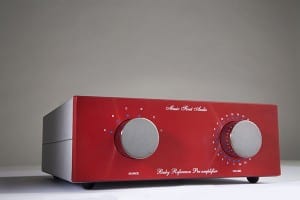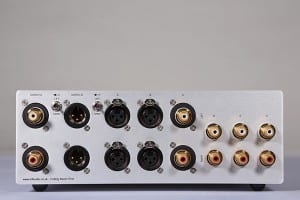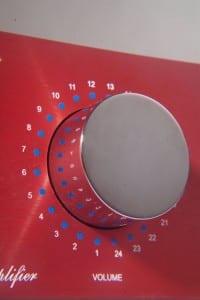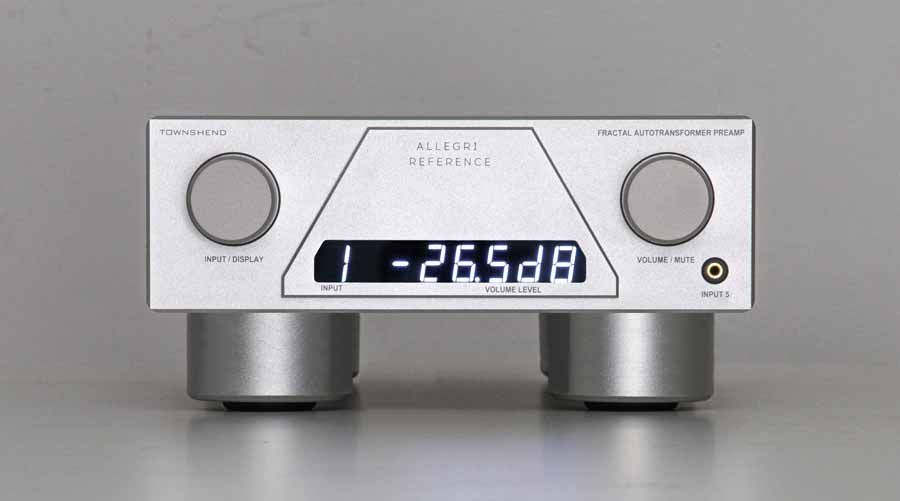Having spent a lot of hours and money trying out and buying active pre-amps from USA, Britain and Germany over the years, I  came to the conclusion that all they did was simply add their own imperfections and idiosyncrasies. I could play a track of music and instantly know from listening what pre-amp it passed through. As a sound engineer, a professional musician, composer and a woman, my ears hopefully tick all the right boxes for being reliable at judging what sounds accurate, real and musical, so listening to a passive preamplifier, such as the Baby Reference Pre-Amplifier from Music First Audio seemed a good idea. Indeed, more and more passive preamplifiers are coming on to the market each week, as we begin to realise that all we actually need between a line-level source and power amplifier is some kind of volume control, rather than noise or colouration generated with electronics. Over the last thirty years or so we have realised that for vinyl sources a dedicated amplifier and equalisation unit is far preferable than integrated phono circuitry in a preamplifier. A passive preamplifier is therefore becoming more and more popular.
came to the conclusion that all they did was simply add their own imperfections and idiosyncrasies. I could play a track of music and instantly know from listening what pre-amp it passed through. As a sound engineer, a professional musician, composer and a woman, my ears hopefully tick all the right boxes for being reliable at judging what sounds accurate, real and musical, so listening to a passive preamplifier, such as the Baby Reference Pre-Amplifier from Music First Audio seemed a good idea. Indeed, more and more passive preamplifiers are coming on to the market each week, as we begin to realise that all we actually need between a line-level source and power amplifier is some kind of volume control, rather than noise or colouration generated with electronics. Over the last thirty years or so we have realised that for vinyl sources a dedicated amplifier and equalisation unit is far preferable than integrated phono circuitry in a preamplifier. A passive preamplifier is therefore becoming more and more popular.
Whilst some cheap passive preamplifiers simply have a dual-potentiometer and input switches to do that job (I remember the one I built up in my bedroom when I was very young), even that will add its own sound-print to the original sound, changing impedance with frequency and failing badly in areas such as crosstalk and accuracy between left and right legs. Indeed, a dual-gang potentiometer to control both left and right channels can have tolerance levels as bad as 20% between the two. To reduce this, early passive volume controls were simply a series of discrete resistors. I remember my early days at the BBC World Service using their home-grown rotary Bakelite volume controls on the ‘Type B’ desks, made of a series of resistors out-putting in 2dB steps, meaning you could hear “clicks” as you played a 1KHz tone signal and turned the knob, which seemed to entertain a few of the Studio Managers, I recall. Whereas the idea of using a series of resistors improved the accuracy, it was still not ideal. Their design would create impedance mismatches and, depending on the setting and cable load, frequency response irregularities. Whilst many hi-fi fans will like the tinted glass sound, puritans like myself want nothing added. And where some passive preamplifiers have actually “taken away” from the source, in terms of frequency response or speed, there are a few passives out there that take, nor add, nought. Townshend Audio and Music First Audio are two such examples. In the Auto Transformer system the wires are tapped at different sections of its winding and sent to a series of switches – the rotary volume control. The preamplifier is basically just a series of multi-tapped attenuation transformers; as each switch is engaged, the voltage level and output impedance changes and, unlike a potentiometer there is a greater amount of the incoming voltage that makes its way through without being lost. Therefore, the lower the switching volume control, the lower the impedance, and so this passive preamp particularly works well at low level, whereas many active preamps need to be driven hard to get a good sound, and probably complaints from the neighbours. Channel crosstalk is obviously excellent, since the two channels never come into contact with each other. Being a transformer, it doesn’t suffer the impedance matching issues that can sometimes happen, especially if you run long cable lengths. Indeed, I ran different length cables from the preamp, and didn’t notice any degradation. It also worked just as well into powered speakers I tried. Finally, being a form of isolator, any RFA that came with the source will not make its way passed this device, much like the heavy Isolation Transformers I carried about at the BBC to protect the mains from dirty guest musical instruments so there is no need for mains conditioners , and of course no mains cable. As a transformer there is consistent impedance across all frequencies. What you put in is what you get out!
Many think the use of passive preamplifiers will mean not enough gain to the speakers, but as we progress further with modern-day sources, especially digital to analogue converters, the levels are much higher now than they were 20 years ago, and consequently there is actually no longer any need for any gain in sound level in a pre-amplifier. Being human we tend to think better of spending several thousands of pounds on a complex electronic preamplifier with buttons and lights rather than simply buying a box of wire. Hand building a passive preamplifier actually takes far longer than soldering components onto a circuit board, and wire is not cheap!
In my own set-up I have gone the passive route, and have never ever regretted it. Having bought the original MFA Classic preamp the prospect of listening to the Baby Reference was an opportunity I didn’t want to miss. Playing a wide range of sources and an equally extensive choice of music types took my music to an altogether new level, and something I would never have believed had I not auditioned it. What I had already heard as crystal clear reproduction got even clearer and with frequency extension. Since there is no active circuitry there is little to limit frequency response, so 10-100,000Hz is easily possible, and therefore nothing is quoted on the website. Similarly, there is no noise created in the unit, which should make your power amp sound better than you thought it ever could. At 88mm x 250mm x 260mm, it is a tad wider and deeper than the Classic, but still very compact, especially considering the 6 inputs and two outputs at the back made of a mixture of XLR and RCA connections. Indeed, you can contact Mr Billington at Music First Audio and choose the permutations you so desire. My model had 3 balanced XLR and 3 RCA inputs and both XLR and RCA outputs, all using high quality gold plated connectors. And, because the unit is basically a transformer, it means you can connect an unbalanced source and get a true balanced output signal from the XLR. Listening to music there was a new standard of resolution and timbre, making it easier to distinguish individual sounds and their placement within the soundstage. I was now wearing virtual 3D glasses for my ears! Whilst I have heard some of MFA’s competition, their Baby Reference gives a tighter and quicker top end, perhaps with a slight deficit in the very lower frequencies compared with, say, Townshend Audio’s Allegri Autotransformer passive preamplifier. However, there is nothing missing. You can still hear the sounds of lorries driving past the cellos outside of the Sofiensaal concert hall in Vienna in the recording there of Mars from ‘Holst Planet Suite’, Karajan, Decca. The cymbals in ‘Live: A Fortnight In France’, Patricia Barber, is equally realistic and stimulating. The album ‘Aerial’, by Kate Bush, essentially a multi-layered work recorded by her in her own studio, complete with occasional harmonic distortion and level mismatches, can be easily dissected but still sound very musical with the Baby Reference. All its eccentricities come to life with the Baby Reference, including the wide dynamic range and despite the didgeridoo and voice of Rolf Harris. Whilst both these models use copper wire, they sound surprisingly different. The Townshend uses the Fractal (EDCT) copper wire with 80% nickel mu-metal laminations for ultimate performance, and this MFA Baby uses the TX102 MkIV in its ‘Nickel Brick’ guise with a nickel Permalloy core, with transformers 25% bigger than that used in the Classic Preamplifier, and bigger than in the Townshend, not that size matters here. Whilst so much can be assumed to be similar both manufacturers keep their methodology tight-lipped, and these machines are surprisingly different in sound. If you are unsure which to buy, listening sessions of both is advised, and also do bear in mind inputs and outputs as well as price difference when choosing. The Mk IV is a complete revision of the excellent original TX102. The transformers are a labyrinth of layers of winding wire and paper, resulting in a very complex construction making it time consuming to build. As with the Classic Preamplifier, it features twenty three separate ‘taps’ for a total of twenty four (including mute) discreet volume steps. The extra work in all this hand wiring shows in the sound in the output.
the prospect of listening to the Baby Reference was an opportunity I didn’t want to miss. Playing a wide range of sources and an equally extensive choice of music types took my music to an altogether new level, and something I would never have believed had I not auditioned it. What I had already heard as crystal clear reproduction got even clearer and with frequency extension. Since there is no active circuitry there is little to limit frequency response, so 10-100,000Hz is easily possible, and therefore nothing is quoted on the website. Similarly, there is no noise created in the unit, which should make your power amp sound better than you thought it ever could. At 88mm x 250mm x 260mm, it is a tad wider and deeper than the Classic, but still very compact, especially considering the 6 inputs and two outputs at the back made of a mixture of XLR and RCA connections. Indeed, you can contact Mr Billington at Music First Audio and choose the permutations you so desire. My model had 3 balanced XLR and 3 RCA inputs and both XLR and RCA outputs, all using high quality gold plated connectors. And, because the unit is basically a transformer, it means you can connect an unbalanced source and get a true balanced output signal from the XLR. Listening to music there was a new standard of resolution and timbre, making it easier to distinguish individual sounds and their placement within the soundstage. I was now wearing virtual 3D glasses for my ears! Whilst I have heard some of MFA’s competition, their Baby Reference gives a tighter and quicker top end, perhaps with a slight deficit in the very lower frequencies compared with, say, Townshend Audio’s Allegri Autotransformer passive preamplifier. However, there is nothing missing. You can still hear the sounds of lorries driving past the cellos outside of the Sofiensaal concert hall in Vienna in the recording there of Mars from ‘Holst Planet Suite’, Karajan, Decca. The cymbals in ‘Live: A Fortnight In France’, Patricia Barber, is equally realistic and stimulating. The album ‘Aerial’, by Kate Bush, essentially a multi-layered work recorded by her in her own studio, complete with occasional harmonic distortion and level mismatches, can be easily dissected but still sound very musical with the Baby Reference. All its eccentricities come to life with the Baby Reference, including the wide dynamic range and despite the didgeridoo and voice of Rolf Harris. Whilst both these models use copper wire, they sound surprisingly different. The Townshend uses the Fractal (EDCT) copper wire with 80% nickel mu-metal laminations for ultimate performance, and this MFA Baby uses the TX102 MkIV in its ‘Nickel Brick’ guise with a nickel Permalloy core, with transformers 25% bigger than that used in the Classic Preamplifier, and bigger than in the Townshend, not that size matters here. Whilst so much can be assumed to be similar both manufacturers keep their methodology tight-lipped, and these machines are surprisingly different in sound. If you are unsure which to buy, listening sessions of both is advised, and also do bear in mind inputs and outputs as well as price difference when choosing. The Mk IV is a complete revision of the excellent original TX102. The transformers are a labyrinth of layers of winding wire and paper, resulting in a very complex construction making it time consuming to build. As with the Classic Preamplifier, it features twenty three separate ‘taps’ for a total of twenty four (including mute) discreet volume steps. The extra work in all this hand wiring shows in the sound in the output.
The Townshend and MFA are not here for comparison (that would be a first); both sound amazing and different. Compared with  other passive and active preamplifiers these, at time of print, are the two best I have ever heard. What makes me so excited about the Baby is the fact it is so much better than the Classic, which was already my choice at home, and comes with balanced ins and outs, something missing in the Allegri. I must stress, however, that there is a vast price difference between the Townshend and MFA. With the £5,000 +VAT Baby Reference I now could experience greater dynamic range and a bass to die for; not OTT but uncluttered and incredibly fast. Put up against my Audio Research, Krell and Manley preamplifiers there was just no competition. This was sweet music to my ears. Brass had bite, clarinets had clarity and piano had power. Indeed, the latter sounded like I had a 9 foot Steinway in the room, rather than an upright on steroids (as with many an active pre-amp), and I was left compelled to listen to the musicians in my room. All the time, every day! The speed of sound and sheer clarity of audio was what made this, for me, the king of the passive preamplifiers. Coupled with my meaty Krell poweramp, and Townshend Rock 7/Rega/Kontrupunkt b/Manley Steelhead source, I was in another world.
other passive and active preamplifiers these, at time of print, are the two best I have ever heard. What makes me so excited about the Baby is the fact it is so much better than the Classic, which was already my choice at home, and comes with balanced ins and outs, something missing in the Allegri. I must stress, however, that there is a vast price difference between the Townshend and MFA. With the £5,000 +VAT Baby Reference I now could experience greater dynamic range and a bass to die for; not OTT but uncluttered and incredibly fast. Put up against my Audio Research, Krell and Manley preamplifiers there was just no competition. This was sweet music to my ears. Brass had bite, clarinets had clarity and piano had power. Indeed, the latter sounded like I had a 9 foot Steinway in the room, rather than an upright on steroids (as with many an active pre-amp), and I was left compelled to listen to the musicians in my room. All the time, every day! The speed of sound and sheer clarity of audio was what made this, for me, the king of the passive preamplifiers. Coupled with my meaty Krell poweramp, and Townshend Rock 7/Rega/Kontrupunkt b/Manley Steelhead source, I was in another world.
Finally, what makes all this even more exciting is the choice of 4 colours (black, blue, silver, red). I am a woman, after all!
Conclusion If you have over £5000 to spend on a preamp, and aren’t flustered by not having lights and something to plug in to the mains, you would do very well to give this little Baby a listening. For me this is the King of preamps and certainly lives up to its name Baby Reference.
Janine Elliott
Build quality 8.5
Sound quality 9.0
Value for money 8.4
Total 8.63*




















































































































































































You must be logged in to leave a reply.